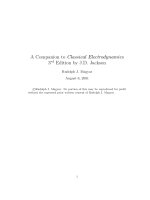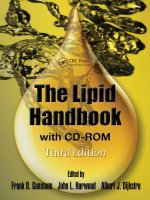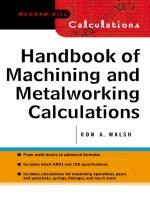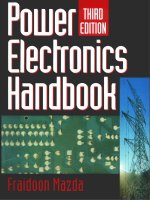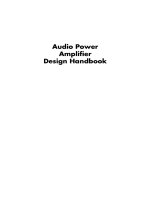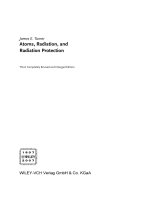McGraw-Hill Machining and Metalworking Handbook 3rd ed - R. Walsh_ D. Cormier (McGraw-Hill 2006) WW Part 14 docx
Bạn đang xem bản rút gọn của tài liệu. Xem và tải ngay bản đầy đủ của tài liệu tại đây (1.51 MB, 66 trang )
aluminum alloys, and stainless steels. Figure 14.38 shows the sizes
and dimensions of standard clamp-collars, and Fig. 14.39 shows
the data for the internally threaded clamp-collar series.
Split-collars and threaded split-collars are also available and used
widely in machine design. The data for these types of clamping
collars are shown in Figs. 14.40 and 14.41.
Note: Figures 14.37 through 14.41 were extracted from the
Ruland catalog of collars and couplings (Ruland Manufacturing
Company, Inc., Watertown, MA 02172).
14.7 Machinery Bushings, Shims,
and Arbor Spacers
14.7.1 Machinery bushings
Machinery bushings are a special form of flat washer commonly
made of low-carbon mild steel. They are used as spacers between
gears, pulleys, and sprockets and as filler spacers for parts mounted
on shafts. These bushings are manufactured in the following gauges
and diameters:
■
18 gauge, 0.048 in
■
14 gauge, 0.075 in
■
10 gauge, 0.134 in
■
3
⁄16 in, 0.1875 in
Inside diameters range from 0.500 through 3.00 in.
14.7.2 Steel shims
Steel shims are thin steel rings with a plain center hole that are used
for building up gears and bearings and to provide proper clearance
between mating parts. Figure 14.42 lists the sizes and thicknesses
normally available for steel shims.
14.7.3 Steel arbor spacers
Steel arbor spacers are thin steel rings with a keyway center hole
that are used for accurately spacing milling cutters, slitter knives,
and gang saws on keyway arbors. Steel shims and steel arbor spacers
are made of AISI 1010, fully hardened, cold-rolled low-carbon steel.
Figure 14.42 also lists the sizes and thicknesses of steel arbor spacers.
Fastening and Joining Techniques and Hardware 909
Walsh CH14 8/31/05 4:00 PM Page 909
Downloaded from Digital Engineering Library @ McGraw-Hill (www.digitalengineeringlibrary.com)
Copyright © 2004 The McGraw-Hill Companies. All rights reserved.
Any use is subject to the Terms of Use as given at the website.
Fastening and Joining Techniques and Hardware
910 Chapter Fourteen
Figure 14.38 Clamp-collars. (Ruland, Inc.)
Walsh CH14 8/31/05 4:00 PM Page 910
Downloaded from Digital Engineering Library @ McGraw-Hill (www.digitalengineeringlibrary.com)
Copyright © 2004 The McGraw-Hill Companies. All rights reserved.
Any use is subject to the Terms of Use as given at the website.
Fastening and Joining Techniques and Hardware
14.8 Specialty Fasteners
The specialty fastener component lines available today are great in
numbers and types. This section will detail only those specialty fas-
teners which have become common and which are used widely in new
product design and manufacturing.
A partial listing of some of the common specialty fasteners would
include
■
Acorn nuts
■
Floating nuts
Fastening and Joining Techniques and Hardware 911
Figure 14.39 Threaded clamp-collars. (Ruland, Inc.)
Walsh CH14 8/31/05 4:00 PM Page 911
Downloaded from Digital Engineering Library @ McGraw-Hill (www.digitalengineeringlibrary.com)
Copyright © 2004 The McGraw-Hill Companies. All rights reserved.
Any use is subject to the Terms of Use as given at the website.
Fastening and Joining Techniques and Hardware
912 Chapter Fourteen
Figure 14.40 Split-collars. (Ruland, Inc.)
Walsh CH14 8/31/05 4:00 PM Page 912
Downloaded from Digital Engineering Library @ McGraw-Hill (www.digitalengineeringlibrary.com)
Copyright © 2004 The McGraw-Hill Companies. All rights reserved.
Any use is subject to the Terms of Use as given at the website.
Fastening and Joining Techniques and Hardware
■
Plastic bolts
■
Split lock nuts
■
SEMs
■
Weld nuts
■
Various plastic washers
■
Sealing washers
■
T-slot nuts and bolts
■
Push nuts (pal nuts)
Fastening and Joining Techniques and Hardware 913
Figure 14.41 Split threaded clamp-collars. (Ruland, Inc.)
Walsh CH14 8/31/05 4:00 PM Page 913
Downloaded from Digital Engineering Library @ McGraw-Hill (www.digitalengineeringlibrary.com)
Copyright © 2004 The McGraw-Hill Companies. All rights reserved.
Any use is subject to the Terms of Use as given at the website.
Fastening and Joining Techniques and Hardware
914
Figure 14.42 Steel shims and arbor spacers.
Walsh CH14 8/31/05 4:00 PM Page 914
Downloaded from Digital Engineering Library @ McGraw-Hill (www.digitalengineeringlibrary.com)
Copyright © 2004 The McGraw-Hill Companies. All rights reserved.
Any use is subject to the Terms of Use as given at the website.
Fastening and Joining Techniques and Hardware
■
Various types of weld studs
■
Sheet metal nuts
■
Nylok bolts
■
Flanged “whiz” bolts
■
Turnbuckles
14.8.1 Specialty fasteners in common use
Figure 14.43 shows the different types of SEMs (screw and captive
washer assemblies) available today. Note that on the SEM, the screw
is either thread-forming or thread-tapping. This makes this class of
fastener useful and economical in rapid-assembly applications such
as automotive equipment manufacturing. SEMs are specified in
ANSI Standard ANSI/ASME B18.13.
Figure 14.44 shows some of the widely used Tinnerman types of
speed nuts, which are made of high-carbon, spring-tempered steel.
These types of speed nuts are produced in sizes from 6-32 through
5
⁄16-18 or larger in special cases. The Tinnerman type U and J nuts
are used widely to fasten sheet metal screw covers onto sheet metal
enclosures. The flat and round types are used on through-bolt sheet
metal applications, such as automotive equipment and electronic
chassis work. These are economical, efficient fasteners whose appli-
cations are limitless.
Another specialty type of fastener that is used widely is the swage
nut. The swage nut is produced in several different styles, one of
which is shown in Fig. 14.45a. The swage nut is extremely useful in
applications where the thread cannot be produced efficiently or effec-
tively in a parent metal that must be fastened to another part. Swage
nuts are used in switch-gear equipment where copper bus bars are
fastened together, and it is not practical to tap the soft copper bars for
bolting. These nuts are also used on thin sheet metal parts where a
strong joint is required, and not enough material thickness is avail-
able for tapping the sheet metal. The swage nut normally is made
from carbon steel with zinc or cadmium plating, stainless steels, and
aluminum alloys. Figure 14.45a shows a typical PEM-type nut.
The Rivnut and Plusnut, which are produced by B. F. Goodrich
Company, are shown in Fig. 14.45b and c. These types of “blind”
fasteners have countless applications in industry and are also pro-
duced with sealed ends for liquid-proofing applications. The Rivnut
is used widely in the aerospace industry.
Fastening and Joining Techniques and Hardware 915
Walsh CH14 8/31/05 4:00 PM Page 915
Downloaded from Digital Engineering Library @ McGraw-Hill (www.digitalengineeringlibrary.com)
Copyright © 2004 The McGraw-Hill Companies. All rights reserved.
Any use is subject to the Terms of Use as given at the website.
Fastening and Joining Techniques and Hardware
14.8.2 Electroplating fasteners
High-quality fasteners such as the Unbrako series of socket-head
cap screws and shoulder bolts, which use the UNR thread profile,
may be precision plated according to Table 14.2. Other types of fas-
teners also may use the plating specifications shown in Table 14.2.
Figure 14.43 Types of SEMs.
(Text continued on page 922.)
916
Walsh CH14 8/31/05 4:00 PM Page 916
Downloaded from Digital Engineering Library @ McGraw-Hill (www.digitalengineeringlibrary.com)
Copyright © 2004 The McGraw-Hill Companies. All rights reserved.
Any use is subject to the Terms of Use as given at the website.
Fastening and Joining Techniques and Hardware
Fastening and Joining Techniques and Hardware 917
Figure 14.44 Tinnerman speed nuts.
Walsh CH14 8/31/05 4:00 PM Page 917
Downloaded from Digital Engineering Library @ McGraw-Hill (www.digitalengineeringlibrary.com)
Copyright © 2004 The McGraw-Hill Companies. All rights reserved.
Any use is subject to the Terms of Use as given at the website.
Fastening and Joining Techniques and Hardware
918 Chapter Fourteen
Figure 14.44 (Continued)
Walsh CH14 8/31/05 4:00 PM Page 918
Downloaded from Digital Engineering Library @ McGraw-Hill (www.digitalengineeringlibrary.com)
Copyright © 2004 The McGraw-Hill Companies. All rights reserved.
Any use is subject to the Terms of Use as given at the website.
Fastening and Joining Techniques and Hardware
Fastening and Joining Techniques and Hardware 919
Figure 14.45 (a) Clinch or swage nut. (b) Rivnut installation. (c) Installed
Plusnut.
Walsh CH14 8/31/05 4:00 PM Page 919
Downloaded from Digital Engineering Library @ McGraw-Hill (www.digitalengineeringlibrary.com)
Copyright © 2004 The McGraw-Hill Companies. All rights reserved.
Any use is subject to the Terms of Use as given at the website.
Fastening and Joining Techniques and Hardware
TABLE 14.2 Precision Plating Specifications for Fasteners
Thickness (minimum), in
Pre- or postplate
treatments or Typical
Type A B C instructions specifications
Cadmium 0.0002 0.0003 0.0005 Clear postplate dip AMS 2400 and
QQ-P-416, type I
Cadmium 0.0002 0.0003 0.0005 Olive drab chromate QQ-P-416, type II
Cadmium 0.0002 0.0003 0.0005 Iridescent dichromate QQ-P-416, type II
Zinc 0.0002 0.0003 0.0005 Clear bright ASTM B633, type III
Zinc 0.0002 0.0003 0.0005 Olive drab chromate ASTM B633, type II
Zinc 0.0002 0.0003 0.0005 Iridescent dichromate ASTM B633, type II
Zinc 0.0002 0.0003 0.0005 Supplementary ASTM B633, type IV
phosphate
Silver 0.0002 0.0003 0.0005 Nickel strike AMS 2410, AMS 2411
Black oxide Alloy or 18-8 stainless
AMS 2485,
carbon steel
Mil-C-13924
Dull nickel 0.0002 0.0003 0.0005 AMS 2403
Copper 0.0002 0.0003 0.0005 AMS 2418
Tin 0.0002 0.0003 0.0005 AMS 2408,
Mil-T-10727, type I
Phosphate (class A) Dry Nondrying oil Manganese phosphate AMS 2481,
(Parker-Lubrite)
DOD-P-16232
Phosphate Dry Drying oil Zinc phosphate AMS 2480,
(class B)
DOD-P-16232
(Parkerizing)
Cadmium 0.0002 0.0003 0.0005 Black dye over QQ-P-416 type II
olive drab chromate except color
920
Walsh CH14 8/31/05 4:00 PM Page 920
Downloaded from Digital Engineering Library @ McGraw-Hill (www.digitalengineeringlibrary.com)
Copyright © 2004 The McGraw-Hill Companies. All rights reserved.
Any use is subject to the Terms of Use as given at the website.
Fastening and Joining Techniques and Hardware
Cadmium 0.0002 0.0003 0.0005 Fluoborate bath, bake NAS 672
at 375° for 23 h,
iridescent dichromateSilver 0.0002 0.0003
0.0005 Copper strike AMS 2412
Nickel 0.0002 NI Thermal treat 630° AMS 2416
Cadmium 0.0001 CD
Vacuum cadmium 0.0002 0.0003 0.0005 Mil-C-8837, type I
Cadmium 0.0002 0.0003 0.0005 Supplementary QQ-P-416, type III
phosphate
Vacuum cadmium 0.0002 0.0003 0.0005 Iridescent dichromate Mil-C-8837, type II
“Cronak” or equivalent
Molydisulfide
Available with a variety
coating
of carriers, concentrations,
and treatments to customer
requirements
Passivation
For austenitic series QQ-P-35
stainless steel
Passivation
For 400 series
stainless steel
Cadmium 0.0002 0.0003 0.0005 Clear postplate dip AMS 2401
Sermetel
AMS 2506
“Metric” blue dye
IVD aluminum 0.0010 0.0005 0.0003 Supplementary Mil-C-83488, type II
chromate
921
Walsh CH14 8/31/05 4:00 PM Page 921
Downloaded from Digital Engineering Library @ McGraw-Hill (www.digitalengineeringlibrary.com)
Copyright © 2004 The McGraw-Hill Companies. All rights reserved.
Any use is subject to the Terms of Use as given at the website.
Fastening and Joining Techniques and Hardware
For more complete information on electroplating, see Chap. 13,
“Plating Practices and Finishes.”
14.9 Welding, Brazing, and Soldering
Welding, brazing, and soldering are all important methods of join-
ing and fastening metals and alloys. This section will detail the
various methods or processes and materials used in these three
types of joining techniques.
14.9.1 Welding
Welding is a fusion process for joining metals. The heat of applica-
tion causes mixing of the joint metals or of the filler metal and the
joint metal. The resulting joint is as strong as the parent metal,
provided the weld is made correctly.
Numerous welding methods or techniques are in common use for
a vast array of applications. Modern welding methods or techniques
are categorized in Fig. 14.46, which shows the process and the
American Welding Society (AWS) designation. Both welding and
cutting processes for metals are shown in the figure.
Although the list of processes shown in Fig. 14.46 is extensive,
the majority of welding is done by the following methods:
■
Stick welding (fluxed rod)—SMAW
■
MIG (metal inert gas) welding—GMAW
■
TIG (tungsten inert gas) welding—GTAW
■
Stud arc welding—SW
Whether the welding process is gas or arc, the welder may pro-
ceed to do the weld in the forward or backward direction, as shown
in Fig. 14.47. The direction of welding is left to the judgment of the
welder based on the configuration of the object being welded. When
the welder is looking down at the welded joint, this is normally
called in-position welding. When the welder is looking up at the joint,
this is called out-of-position welding. Any orientation not looking
down at the weld can be considered as out-of-position welding.
Each of the various welding processes produces physical charac-
teristics that allow the process to be identified by direct eye inspec-
tion. Figure 14.48 shows an assembly welded using the MIG process
(GMAW). Here, the weld is rather rough looking and was difficult
922 Chapter Fourteen
Walsh CH14 8/31/05 4:00 PM Page 922
Downloaded from Digital Engineering Library @ McGraw-Hill (www.digitalengineeringlibrary.com)
Copyright © 2004 The McGraw-Hill Companies. All rights reserved.
Any use is subject to the Terms of Use as given at the website.
Fastening and Joining Techniques and Hardware
to clean mechanically. The welding heat setting and the diameter
of the weld wire play important roles in producing a neat, clean weld
that is also mechanically sound. Figure 14.49 shows the same type
of joint (using the same parts) that has been welded using the TIG
process (GTAW). It is immediately apparent that the TIG process is
more advantageous in this application, from the point of view of
both strength and cosmetic appearance. This joint is comprised of
parts manufactured from AISI 304 type stainless steel. Figure
14.49 shows the welded assembly sand-blasted after welding. The
TIG weld in this application was made efficiently and correctly by
a skilled welder. Welding is an art as well as a science, and a good
welder needs a great deal of practice and experience.
Fastening and Joining Techniques and Hardware 923
Figure 14.46 Welding processes and designations.
Walsh CH14 8/31/05 4:01 PM Page 923
Downloaded from Digital Engineering Library @ McGraw-Hill (www.digitalengineeringlibrary.com)
Copyright © 2004 The McGraw-Hill Companies. All rights reserved.
Any use is subject to the Terms of Use as given at the website.
Fastening and Joining Techniques and Hardware
In a welded assembly of numerous parts, the welder’s skill and
experience play an important role in producing an acceptable final
weld assembly. Many welded assemblies require additional machin-
ing after the welding process because of the strains produced when
the welded joints cool to room temperature. Allowance must be
made in the design of such an assembly to accommodate these weld-
ing distortions, which are sometimes unavoidable.
924 Chapter Fourteen
Figure 14.47 (a) Forward. (b) Backward.
Walsh CH14 8/31/05 4:01 PM Page 924
Downloaded from Digital Engineering Library @ McGraw-Hill (www.digitalengineeringlibrary.com)
Copyright © 2004 The McGraw-Hill Companies. All rights reserved.
Any use is subject to the Terms of Use as given at the website.
Fastening and Joining Techniques and Hardware
Fastening and Joining Techniques and Hardware 925
Figure 14.49 TIG-welded assembly.
Figure 14.48 MIG-welded assembly.
Walsh CH14 8/31/05 4:01 PM Page 925
Downloaded from Digital Engineering Library @ McGraw-Hill (www.digitalengineeringlibrary.com)
Copyright © 2004 The McGraw-Hill Companies. All rights reserved.
Any use is subject to the Terms of Use as given at the website.
Fastening and Joining Techniques and Hardware
Welding procedures and electrode sizes. The correct electrode size is
one that, when used with the proper amperage and travel speed,
produces a weld of the required size in the least amount of time. The
electrode diameter selected for use depends largely on the thick-
ness of the material to be welded, the position in which welding is
to be performed, and the type of joint to be welded. In general, larger
electrodes will be selected for applications involving thicker mate-
rials and for welding in the flat position in order to take advantage
of their higher deposition rates.
For welding in the horizontal, vertical, and overhead positions, the
molten weld metal tends to flow out of the joint owing to gravity.
This can be controlled by using small electrodes to reduce the weld
pool size. Electrode manipulation and increased travel speed along
the weld joint also aid in controlling the weld pool size.
Weld groove design also must be considered when electrode size
is selected. The experience of the welder often has a bearing on the
size of the electrode. This is particularly true for out-of-position
welding because the welder’s skill determines the size of the molten
pool that the welder can control.
Welds that are larger than necessary are more costly and, in cer-
tain instances, actually are harmful to the joint. Any sudden change
in section size or contour of a weld, such as that caused by overweld-
ing, creates stress concentrations. An improperly welded assembly
of parts will distort on cooling, and an experienced welder can pre-
vent this to a certain degree by applying the welds at the correct
points and in the correct sequences. Tooling fixtures and weld jigs play
an important role in controlling the distortion of welded assemblies
when they are designed and applied properly.
Shielded-metal arc welding can be accomplished with either alter-
nating current (ac) or direct current (dc) when the appropriate elec-
trode is used. The melting rate of any given electrode is directly
related to the electrical energy supplied to the arc via the welding
controller apparatus.
Direct current (dc) always supplies a steadier arc and smoother
metal transfer than alternating current (ac). Most covered electrodes
operate better on reverse polarity (electrode positive), although
some are suitable for and are even designed for straight-polarity
welding (electrode negative). Reverse polarity produces deeper
weld penetration, whereas straight polarity produces a higher elec-
trode melting rate. Direct current is particularly suitable for thin-
section welding and is preferred for vertical and overhead welding
(out-of-position welding). If arc blow is a problem when welding with
dc, change the current to ac.
926 Chapter Fourteen
Walsh CH14 8/31/05 4:01 PM Page 926
Downloaded from Digital Engineering Library @ McGraw-Hill (www.digitalengineeringlibrary.com)
Copyright © 2004 The McGraw-Hill Companies. All rights reserved.
Any use is subject to the Terms of Use as given at the website.
Fastening and Joining Techniques and Hardware
For SMAW, ac offers advantages over dc; one is the absence of arc
blow, and the other is the cost of the power source for producing the
weld (the welding machine or apparatus). Without arc blow, larger
electrodes and higher welding currents can be used.
Welding technique. In SMAW welding, you first select the proper
equipment, materials, and tools for the job. The type of welding
current and its polarity then must be selected, and the power
source set accordingly. The power source must be set to give the
proper voltampere (VA) characteristic for the size and type of elec-
trode being used.
Strike the arc, for the weld to begin, by tapping the end of the
electrode near the beginning of the weld joint; then quickly move it
to produce an arc of proper length at the beginning of the weld joint.
Then move the electrode uniformly along the joint, keeping a con-
stant arc length as the electrode melts to produce the welded joint.
A good deal of practice is required, especially in out-of-position type
weld joints. To break the welding arc, when the weld joint is com-
pleted, stop the forward motion of the electrode and abruptly with-
draw the electrode away from the joint or move the electrode into the
weld pool quickly to kill the arc and then abruptly remove the elec-
trode, thus breaking the arc.
Note
: Complete welding procedures and data for all welding
processes are prepared by the American Welding Society (AWS) and
are available in handbook form in its Welding Handbook, eighth
edition, in three volumes.
Weld strength: Related equations and tables. Here we will present
the equations for determining the approximate strengths of welded
joints. Any equation involving a process with many variables, such
as welding, can only be an approximation. With this in mind, there-
fore, one should allow a factor of safety when designing and calcu-
lating the strengths of welded joints.
Fillet welds. Refer to Fig. 14.50a. The basic welding equations for
the fillet weld are as follows:
hl
hL
P
S
A
P
S
i
i
=
=
=
0 707.
Fastening and Joining Techniques and Hardware 927
Walsh CH14 8/31/05 4:01 PM Page 927
Downloaded from Digital Engineering Library @ McGraw-Hill (www.digitalengineeringlibrary.com)
Copyright © 2004 The McGraw-Hill Companies. All rights reserved.
Any use is subject to the Terms of Use as given at the website.
Fastening and Joining Techniques and Hardware
where l ϭ leg dimension of fillet weld, in
L ϭ length of fillet weld, in
h ϭ weld throat height, in
P ϭ load, lb
S
i
ϭ induced stress, lb/in
2
A ϭ throat area, in
2
Butt welds (primary). Refer to Fig. 14.50b. The tensile stress in a
butt weld induced by a tensile load P is
where S
t
ϭ tensile stress, lb/in
2
P ϭ tensile load, lb
S
P
td
t
=
L
P
Sh
i
=
928 Chapter Fourteen
Figure 14.50 (a) Fillet weld. (b) Butt weld.
Walsh CH14 8/31/05 4:01 PM Page 928
Downloaded from Digital Engineering Library @ McGraw-Hill (www.digitalengineeringlibrary.com)
Copyright © 2004 The McGraw-Hill Companies. All rights reserved.
Any use is subject to the Terms of Use as given at the website.
Fastening and Joining Techniques and Hardware
t ϭ material thickness, in
d ϭ width of butt welded joint, in
For minimum leg sizes for fillet welds, see Figure 14.51b. For
allowable design strengths and shear forces for fillet welds and
partial penetration groove welds, see Fig. 14.51a.
Example: The allowable unit force for a fillet weld with a 0.25-in leg,
using 80,000-lb/in
2
weld rod or wire, is 16,500 ϫ 0.25 ϭ 4125 lb/in. Thus,
if the weld joint is 3 in long, the force allowable is 4125 ϫ 3 ϭ 12,375 lb.
Plug welds. Plug welds (Fig. 14.52) are useful in sheet metal and
structural design applications. Plug welds are used primarily for
shear loads, although they are not limited to this type of load. A
plug weld may be subjected to a combination of shear and tensile
loads. The typical sizes of plug welds are shown in Fig. 14.51c for
various applications or combinations of material thicknesses. Fig-
ure 14.52 illustrates a typical plug weld.
Note: It should be noted that the weld-strength figures and
tables, allowables, and examples are for static loads only. When the
welded members are dynamically or cyclically loaded, a factor of
safety should be applied. A safety factor of 3 should be applied for
general dynamic conditions. In other words, if the weld joint was
calculated to withstand a load of 3000 pounds force, for dynamic
conditions this load should be reduced to a 1000 pounds force max-
imum. (Divide the calculated load by 3 to arrive at the allowable
load with the factor of safety applied.)
Specifying welds. The type of welding, weld-rod strength and type,
fillet or bead size, location, and length of welds all must be specified
on the welding drawings of a part or assembly. Standard weld sym-
bols recognized by the American Welding Society (AWS) should be
used on the engineering drawings (see “Standard Weld Symbols”
below).
Thin-section parts or any part or assembly that may pose a weld
distortion problem should be reviewed in coordination with the
welding department or welder prior to final design or beginning
the work. Experienced welders usually know or can determine weld-
ing sequences to prevent distortion or keep it to a minimum. Welding
sequence instructions may be required on the welding drawing.
Secondary machining operations usually are performed on a
welded part or assembly after the welding operation to correct
unavoidable distortion or dimensional changes that take place
Fastening and Joining Techniques and Hardware 929
Walsh CH14 8/31/05 4:01 PM Page 929
Downloaded from Digital Engineering Library @ McGraw-Hill (www.digitalengineeringlibrary.com)
Copyright © 2004 The McGraw-Hill Companies. All rights reserved.
Any use is subject to the Terms of Use as given at the website.
Fastening and Joining Techniques and Hardware
930 Chapter Fourteen
Figure 14.51 (a) Allowable shear. (b) Weld leg sizes. (c) Plug weld sizes.
(a)
(b)
(c)
Walsh CH14 8/31/05 4:01 PM Page 930
Downloaded from Digital Engineering Library @ McGraw-Hill (www.digitalengineeringlibrary.com)
Copyright © 2004 The McGraw-Hill Companies. All rights reserved.
Any use is subject to the Terms of Use as given at the website.
Fastening and Joining Techniques and Hardware
during welding. To reduce cost and save welding time, the amount
of welding on a part or assembly should be kept to a minimum, in
accordance with the strength requirements of the design or sealing
requirements.
Standard weld symbols. The basic weld symbols shown in Fig. 14.53
should be used on all welding drawings, especially if the welded part
is sent to an outside vendor or subcontractor. If in-house symbols are
used, these should be noted on the welding drawings so that outside
vendors or subcontractors know their exact meaning. The symbols
shown in the figure are those recognized by the American Welding
Society (AWS), the American Iron and Steel Institute (AISI), the
American Society of Mechanical Engineers (ASME), the Society of
Automotive Engineers (SAE), and other authorities and specification
agencies.
Fastening and Joining Techniques and Hardware 931
Figure 14.52 (a) Section of plug. (b) Plug-welded plates.
(a)
(b)
Walsh CH14 8/31/05 4:01 PM Page 931
Downloaded from Digital Engineering Library @ McGraw-Hill (www.digitalengineeringlibrary.com)
Copyright © 2004 The McGraw-Hill Companies. All rights reserved.
Any use is subject to the Terms of Use as given at the website.
Fastening and Joining Techniques and Hardware
Elements of the welding symbol. When a weld is specified on an
American standard engineering drawing, it should conform to cer-
tain characteristics, which are shown in Fig. 14.54. In this way,
uniformity and complete understanding are maintained between the
welder and the design engineer. Typical welding drawing call-outs
932 Chapter Fourteen
Figure 14.53 Weld symbols.
Walsh CH14 8/31/05 4:01 PM Page 932
Downloaded from Digital Engineering Library @ McGraw-Hill (www.digitalengineeringlibrary.com)
Copyright © 2004 The McGraw-Hill Companies. All rights reserved.
Any use is subject to the Terms of Use as given at the website.
Fastening and Joining Techniques and Hardware
Figure 14.54 Elements of the welding symbol.
933
Walsh CH14 8/31/05 4:01 PM Page 933
Downloaded from Digital Engineering Library @ McGraw-Hill (www.digitalengineeringlibrary.com)
Copyright © 2004 The McGraw-Hill Companies. All rights reserved.
Any use is subject to the Terms of Use as given at the website.
Fastening and Joining Techniques and Hardware

